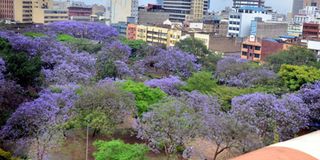Why we should embrace green infrastructure

The aerial view of Jevanjee Gardens in Nairobi on October 24, 2018.
What you need to know:
- It has been projected that urban population is expected to reach 70 per cent by 2050.
- Arguably, the cheapest and most tangible climate change solution is going natural — embracing green infrastructure.
Over the years, there has been a dramatic growth of industrialisation, resulting in rapid urbanisation. While this has improved standards of living, it has accelerated global warming, which has evidently been linked to be a key driver of climate change.
On an unprecedented scale, industrial activities generate carbon dioxide, greenhouse gases and other air pollutants into the atmosphere.
These emissions trap sunlight and solar radiations that would normally dissipate into the space after striking the earth’s surface, resulting in rising global temperatures, particularly in urban centres, which are the epicentres of environmental changes.
This leads to a circumstance known as – urban heat island effect – a phenomenon characterised by increased temperatures in urban areas than the surrounding rural environs.
According to the 2019 report of the Intergovernmental Panel on Climate Change, established by the United Nations Environment Programme to provide scientific advisory related to land-climate systems, half of the global population resides in cities.
It has been projected that urban population is expected to reach 70 per cent by 2050. This implies that much of the existing land, including the areas under cultivation, will be converted to urban use. Importantly, most of this growth will be dominant in developing countries. With up to 70 per cent of greenhouse gas emissions contributed by cities, a large proportion of urban population is at risk of being exposed to the negative effects of urban heat island.
Frequent droughts
Sustainable urban planning strategies
These effects range from morbidity and mortality of humans and other organisms, heat waves, frequent droughts, loss of productivity at work, floods, and storms.
Therefore, as the inevitable spawning of metropolis and industries continues to gather pace with its attendant challenges to the environment, it’s prudent to develop sustainable urban planning strategies.
A number of solutions have been recommended, including reducing carbon emissions and adopting cleaner energy technologies. While effective, these solutions are, however, expensive and unfeasible, especially in the developing world, which lack the technological and infrastructural capacity to support the technologies.
Arguably, the cheapest and most tangible climate change solution is going natural — embracing green infrastructure.
This calls for a massive global campaign to increase tree cover in urban settlements. Naturally, trees and other vegetation suck up excess carbon dioxide, a major culprit for global warming, from the atmosphere, uses it along with sunlight for their own growth and release water and oxygen in return, resulting in a cooling effect.
[email protected] or @KerimaZablon





